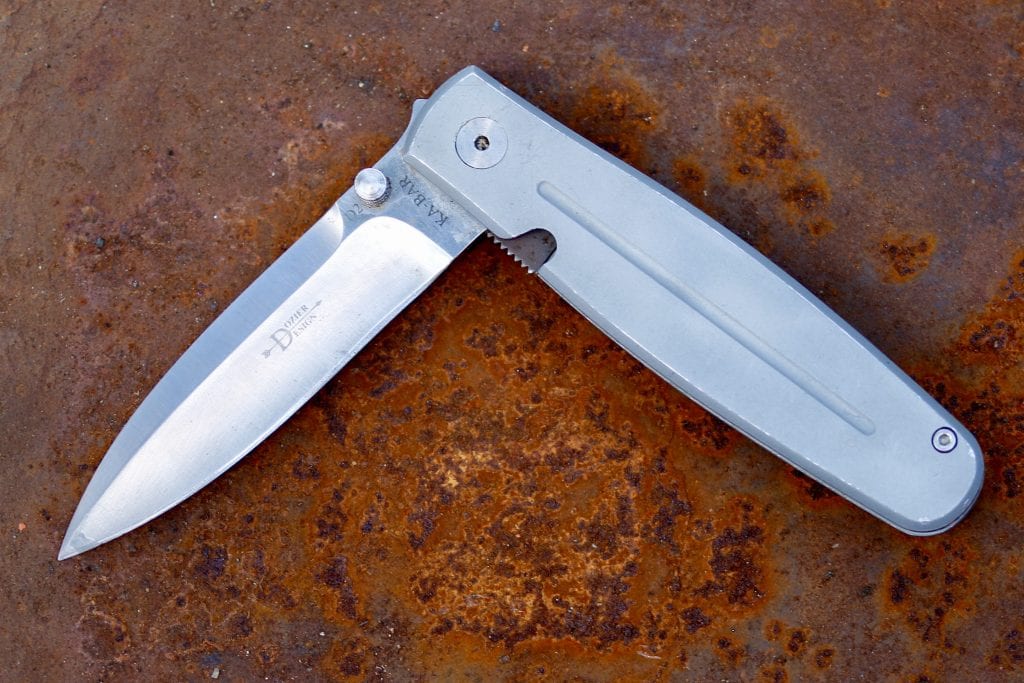Beginning the first Sunday in October, The Mag Life Blog is beginning a new series on knives: Keen Insights. Knives and guns are a bit like chocolate and peanut butter, so we’ll skip the justifications—but here’s the overview. Knives are often permitted where guns are not. So they’re what you carry when you can’t carry.
But most of us carry them anyhow, and everywhere we go.

Keen Insights
My background
I’ve been carrying knives much longer than I’ve been carrying guns. I had a knife in my pocket by the age of six and am never without one unless I’m on a plane. I even practiced off-body carry with fixed blades as early as middle school. It was before the term off-body-carry even existed, and a completely different time.
I come by the practice naturally. I’m an Eagle Scout and currently a Scoutmaster for two troops (one troop of boys and one troop of girls). I was raised believing in the utilitarian function of knives and have become well versed in their use in self-defense. I regularly preach the faith to teenagers who look at me like I’m crazy when I make them turn out their pockets to see what they’re carrying.
I’ve even made many of my own knives. While this is, at best, a hobby—it is one that I know well. From the basics of stock reduction to forging and pattern welding, I know the processes, techniques, tools, and materials from first-hand experience.
I’m far from a master bladesmith, but I can talk the talk.

Knife Reviews & Knowledge
In this series, we’ll be looking at blades and exploring some deep philosophical questions that have been around as long as humans have refined edges.
We’ll begin with The Mag Life Blog’s typical deep-dive review strategies. Our writers are all passionate about their blades. They have opinions that we’ll share based on practical experience.
Understand that these reviews aren’t going to be manufacturer-sponsored torture tests designed to push knives to their limit, and beyond. We’re gun guys. Every knife I own I’ve either made, inherited, or paid for myself.
In addition to the reviews, we’ll be breaking down different types of use. From the classic slip-joints that defined the 20th century, to the skeletal frame-locks in vogue today, we’ll help with the definitions and break apart performance characteristics in ways that matter.
When we get into fighting knives, the debate is likely to explode. What is the role of the big knives? What’s the perfect balance between weight and strength?

As it is with guns, many of the voices we’ll feature in this column won’t agree. That’s to be expected and we aren’t going to please all the manufacturers with what we say, either. And I think it is safe to say that some of what we say might alienate some of our readers, too.
In the end, though, our aim is edification. The perspectives we bring should open the conversation. We’re here to answer questions and will do our best to provide a complete picture of every topic.
An anecdote
Almost a decade ago, I was writing for a knife magazine. They had a regular column on metallurgy—one that was intended to be a deep-dive into the nuances of performance-driven knife steels at a highly technical level.
I wasn’t the best choice for the series—as close as I want to get to anything stainless is D2, and I’d much rather have something with a high-carbon content. As long as it will hold an edge, I’m good with it–but I knew how to do the research.
This series, though, was really designed to sell readers on the latest fad composites. So I dove in. After several issues, I was sent to interview an internationally known pattern-welded steel maker.
We talked for some time about his process, but he kept shying away from questions about the actual composition of his end product. Knowing that this was exactly the focal point I was supposed to discern, I pressed on. But he shut me down.
Maybe it was a trade secret, I supposed. Pattern-welded steel—often referred to as Damascus—combines layers of material over and over. In the end, after a blade is shaped and polished, the blade will be etched in something acidic.
It is this final step that allows for all the intricate layers to emerge. Nickel and 1095 steel will erode at different rates, for example, so thin ridges appear on the surface, exposing a pattern. And what you include in the mix will also determine the strength of the blade itself and the potential of its cutting edge.
Yet this maker—a man who has made a career out of forging billets that the nation’s best bladesmiths use to make their custom creations—wouldn’t tell me what went into his recipe. And it wasn’t because he was being protective, it was because sometimes he wasn’t sure. His process was more organic.
This was how he explained it. He said he often worked on a billet—combining materials in ways that he hoped would produce good results. Then, maybe, something wouldn’t work out or he would get called away on another project.
The unfinished billet would sit, waiting to be finished. From the outside, rough with scale from the forging process, there was little way to know what was in there. Sometimes he’d move them aside, toss them on the floor, use them as doorstops… for years.
Later, sometimes years later, he’d pick up the billet, put it back under the hammer, and shape it into something usable. A spark test (a common way to identify the metallurgic makeup of an unknown composition) can only tell you so much. The best way is to polish a couple of sides, run a quick etch, and see what you’ve got.
My readers, I told him, weren’t going to like that.
“Then don’t print it,” he said.
Duly noted.
My editor didn’t like it either. Here was an internationally known figure in the knife world throwing cold water on the fad-steel fanboys. If you can temper it so it holds an edge and isn’t brittle, then what does it matter, he was suggesting.
And I get it. There are still times when I look closely at what a blade is made of. Spyderco’s H1 is really appealing, for example, as I’m about to be sailing in the Atlantic with some of those Scouts I mentioned at the beginning of this, but there are other options.

So stay with us
Keen Insights will dive deep into rust resistance and duke it out over fighting knives and dig into pocket carry, EDC fixed blades, automatics, OTFs, thumb-studs, front-flippers, lock-backs, micarta, FRN, G10, bone….If it has to do with blades, we’ll put it under the microscope.
And what do you want to know? Keen Insights is here to help.


